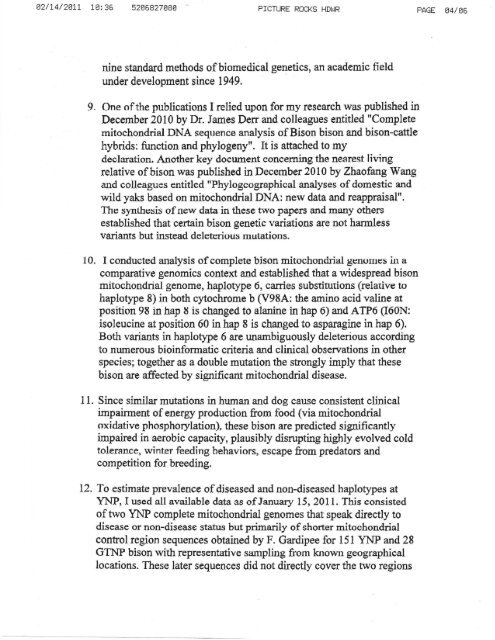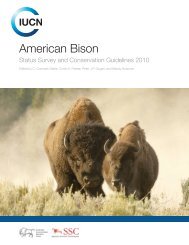Declaration Dr. Thomas H. Pringle - Buffalo Field Campaign
Declaration Dr. Thomas H. Pringle - Buffalo Field Campaign
Declaration Dr. Thomas H. Pringle - Buffalo Field Campaign
Create successful ePaper yourself
Turn your PDF publications into a flip-book with our unique Google optimized e-Paper software.
02/14/2011 10:35 5205827080 " PICTURE ROCKS HDWR<br />
nine standard methods of biomedical genetics, an academic field<br />
under development since 1949.<br />
9. One of the pUblications I relied upon for my research was published in<br />
December 2010 by <strong>Dr</strong>. James Derr and colleagues entitled "Complete<br />
mitochondrial DNA sequence analysis of Bison bison and bison-cattle<br />
hybrids: function and phylogeny". It is attached to my<br />
declaration. Another key document concerning the nearest Hving<br />
relative of bison was published in December 2010 by Zhaofang Wang<br />
and colleagues entitled "Phylogcographical analyses of domestic and<br />
wild yaks based on mitochondrial DNA: new data and reappraisal".<br />
The synthe:sis of new data in these two papers and many others<br />
established that certain bison genetic variations are not hannless<br />
variants but instead deleterious mutations.<br />
10. I conducted analysis of complete bison mitochondrial genumes 1n a<br />
comparative genomics context and established that a widespread bison<br />
mitochondrial genome, haplotype 6, carries substitutions (relative to<br />
haplotype 8) in both cytochrome b (V98A: the amino acid valine at<br />
position 98 in hap H is changed to alanine in hap 6) and ATP6 (I60N:<br />
isoleucine at position 60 in hap 8 is changed to asparagine in hap 6).<br />
Both variants in haplotype 6 are unambiguously deleterious according<br />
to numerous bioinfonnatic criteria and clinical observations in other<br />
species; together as a double mutation the strongly imply that these<br />
bison are affected by significant mitochondrial disease.<br />
11. Since similar mutations in human and dog cause consistent clinical<br />
impairment of energy production from food (via mitochondrial<br />
oxidative phosphorylation). these bison are predicted significantly<br />
impaired in aerobic capacity, plausibly disrupting highly evolved cold<br />
toleran.ce, winter feeding behaviors, escape from predators and<br />
competition for breeding.<br />
12. To estimate prevalence of diseased and non-diseased baplotypes at<br />
YNP, I used all available data as of January 15,2011. This consisted<br />
of two YNP complete mitochondrial genomes that speak: directly to<br />
disease or non-disease status but primarily of shorter mitochondrial<br />
control region sequences obtained by F. Gardipee for 151 YNP and 28<br />
GINP bison with representative saItlpling from known geographical<br />
locations. These later sequences did not directly cover the two regions<br />
PAGE 04/ 05










